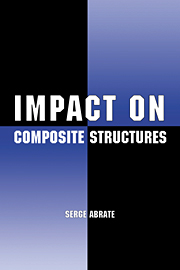6 - Residual Properties
Published online by Cambridge University Press: 19 October 2009
Summary
Introduction
Having studied the dynamics of impact, damage development, and damage prediction methods, the next area of interest is the effect of damage on the mechanical properties of laminated composite structures. This is often called the study of damage tolerance since it refers to the experimental determination or the numerical prediction of the residual mechanical properties of the damaged structure. Many organizations have developed guidelines or requirements for residual strength after impact. For example, U.S. Air Force draft requirements for damage tolerance for low-velocity impacts are that laminates should maintain a minimum design strength after impacts with 100 ft-lb kinetic energy by a 1-in.-diameter hemispherical indenter or after impacts resulting in a 0.10 in. dent, whichever is less severe (Schoeppner 1993).
An understanding of damage tolerance can be gained through experiments and available models for predicting residual properties. The general trend for the residual strength of laminated composites with impact damage is that, for low initial kinetic energy levels, the strength is not affected since little or no damage is introduced. As damage size increases, the strength drops rapidly and then levels off. The effects of impact damage on the residual strength in tension, compression, shear, and bending have been investigated at length and follow the same general trend. Experimental techniques, general results obtained from experiments, and models for predicting residual properties are presented in this chapter.
Compressive Strength
The large number of articles devoted to understanding the compression after impact behavior of composite materials (Table 6.1) is evidence of the importance of the topic and the level of effort focused on it.
Information
- Type
- Chapter
- Information
- Impact on Composite Structures , pp. 172 - 214Publisher: Cambridge University PressPrint publication year: 1998
Accessibility standard: Unknown
Why this information is here
This section outlines the accessibility features of this content - including support for screen readers, full keyboard navigation and high-contrast display options. This may not be relevant for you.Accessibility Information
- 2
- Cited by
